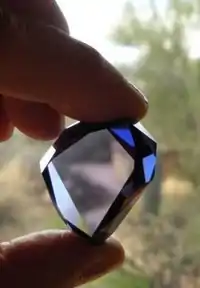Tavernier Blue
The Tavernier Blue was the precursor diamond to the Blue Diamond of the French Crown (aka the French Blue), and subsequently, after a disappearance and reemergence into the public forum, it was renamed the Hope Diamond. This provenance was accepted by many historians and gemologists for years and was supported by research with 3D imaging and prototyping technology in 2005.[1][2] It is a Type IIb diamond.[3]



Weighing 112 3/16 carats[3] (115.16 modern metric carats, erroneously reported by many others as 110+/- carats), the crudely finished gem was described by the French gem dealer Jean-Baptiste Tavernier as a "violet" (which was in those days a synonym for blue) and of perfect clarity. Tavernier was a French traveler and trader, returning to France from India with many of the largest gems of the era, which he primarily sold to the French royalty and aristocracy. The diamond was certainly Indian in origin and likely sourced by Tavernier in 1666[4] at the Kollur mine in Guntur district of Andhra Pradesh. Tavernier sold it to Louis XIV of France.[5]
Five years later the Tavernier Blue was recut by court jeweler Jean Pitau into the 68-carat French Blue.[3] It was reset, though not cut again, in 1749 on the orders of Louis XV.[5] The stone was stolen from the French Crown Jewels in 1792 during the turbulence of the French Revolution.[3] The French Blue was cut into the 45.52-carat Hope Diamond in an attempt to prevent its proper identification.[2]
Another blue diamond believed[6] to have been taken from the Tavernier was originally set as a ring for Empress Maria Feodorovna, wife of Russian Emperor Paul I. It was given to the State Diamond Fund in 1860 by her daughter-in-law, the Empress Alexandra Feodorovna.[7] Later, it was mounted into a stick pin. The 7.6-carat[7] stone is preserved in the collection of the Alexander Palace in Tsarskoye Selo, not far from St Petersburg. The Russian stone's source as part of the Tavernier Blue is disputed.[1]
See also
References
- "Tracing the Hope Diamond's Lineage". Spotlight on Science. Vol. 3 no. 2. Smithsonian Institution. February 25, 2005. Archived from the original on April 4, 2005.
- Wise, Richard W. (2009), "From the Sun King to the Smithsonian: The Epic Journey of the Hope Diamond", The French Blue, retrieved February 24, 2017
- "The Hope Diamond". Encyclopedia Smithsonian. Smithsonian Institution. January 2003. Retrieved February 24, 2017.
- Wise, Richard W. (2010). "Historical Time Line, The French Blue / Part III". The French Blue. Retrieved 9 May 2015.
- "Hope Diamond: Timeline". Treasures of the World. Corporation for Public Broadcasting (PBS). 1999. Retrieved February 24, 2017.
- "Jewels of the Romanovs Treasures - Diamond Stickpin". www.alexanderpalace.org. Retrieved 2020-02-26.
- "STICKPIN: RUSSIA, CIRCA I800". Jewels of the Romanovs - Treasures of the Imperial Court. Alexander Palace. Retrieved February 24, 2017.
| Wikimedia Commons has media related to Tavernier Blue. |